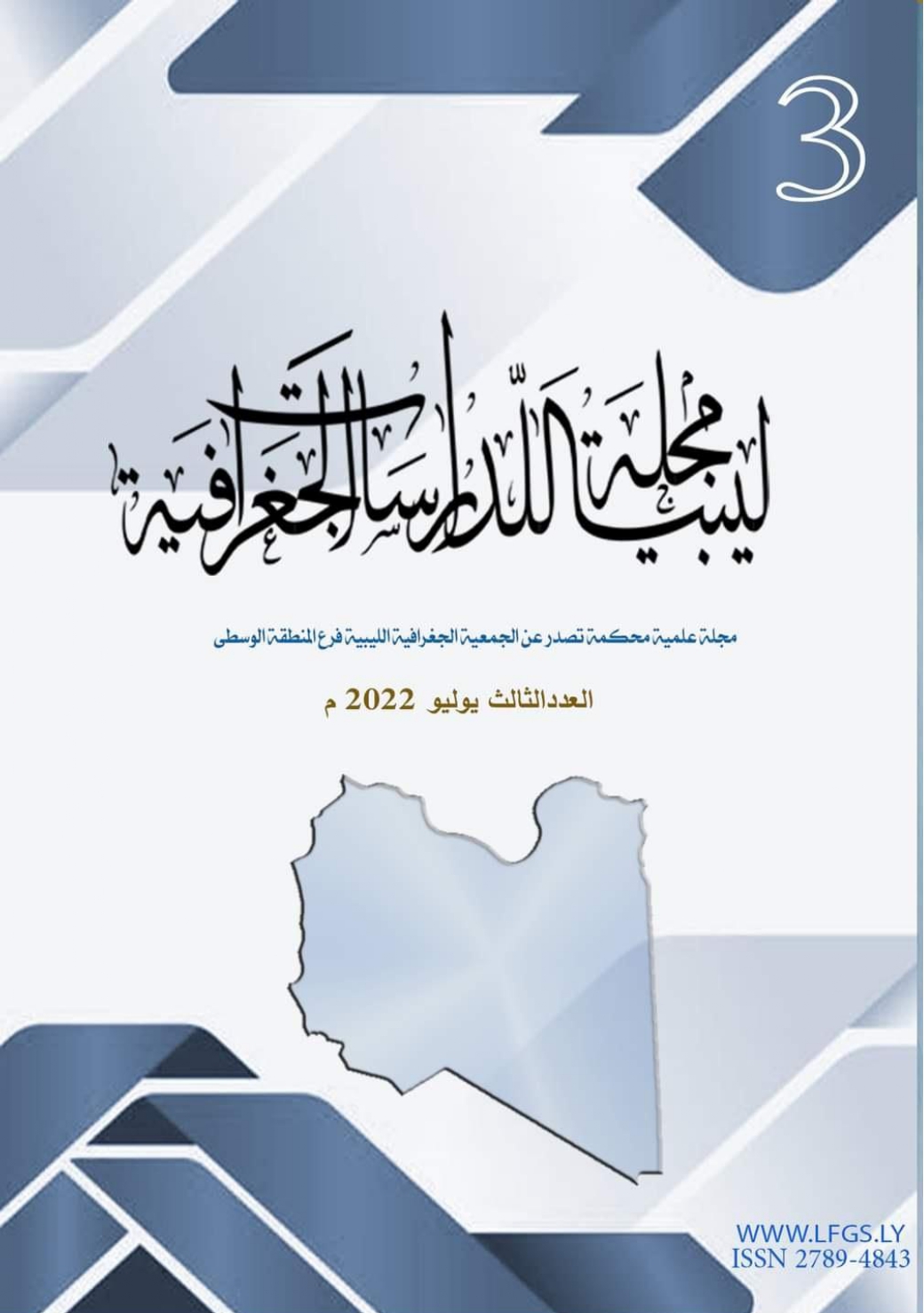The Gulf of Sirte Geographical Link in the Modern History of Libya
DOI:
https://doi.org/10.37375/jlgs.vi3.1750Keywords:
Duality, Geographical Link, Population Growth, spatial analysisAbstract
This study dealt with an important region in the Libyan state, the Gulf of Sirte region, which was described in the past as a geographical separation area between the regions of the historical state. The application of some statistical measures and the theory of accessibility and communication, and the aim of the study is to know the political history of Libya among the historical regions of the Libyan state since the early ages, an attempt to know the factors that helped the Gulf of Sirte to be a geographical link area to Libya and its regions after it was otherwise, and the study concluded that the Gulf of Sirte It is a distinguished location, not in Libya, but in the whole of the Mediterranean basin, and that it is the beating heart of the Libyan state because most of the natural resources have impacted it, and that the population has developed in it from about fifty thousand to nearly half a million people during sixty years, and that the Gulf has a good conductive advantage, as it is easy to reach and connect with from all The Libyan regions, and the study recommends promoting development in the Gulf to further link the two wings of the state. It also recommends transferring the state’s administrative center to it in order to strengthen national unity. Libyan intention.
References
الأعور، محمد علي، (1997)، المظاهر الساحلية وعلاقتها بالتشريعات البحرية الليبية، من كتاب الساحل الليبي (تحرير) الهادي بولقمة، سعد خليل القزيري، منشورات مركز البحوث والاستشارات، جامعة قاريونس، بنغازي.
بن خيال، عبدالحميد (1995)، (فصل الزراعة) من كتاب "الجماهيرية دراسة في الجغرافيا، (تحرير) الهادي ابولقمة، سعد خليل القزيري، الدار الجماهيرية للنشر والتوزيع والاعلان، سرت.
بن عمور، خالد محمد، (2014) التشتت الطبيعي كعامل ضعف جيوبولتيكي في الدولة الليبية دراسة في الجيوبولتيكس، مجلة أبحاث، كلية الآداب جامعة سرت العدد 6، 2014م.
بن عمور، خالد محمد، (2019)، عناصر الضعف الجيوبولتيكية وأثرها في كيان الدولة الليبية دراسة في الجغرافيا السياسية، مجلة أبحاث، كلية الآداب، جامعة سرت، العدد 13، مارس 2019م.
تشيا – لين بان، (2012) سكان ليبيا 1931-1947م، (ترجمة) حسني بن زابيه، مجلة جامعة قاريونس العلمية، العدد الثالث والرابع.
الجماهيرية العربية الليبية الشعبية الاشتراكية العظمى، الهيئة العامة للمعلومات، (2009)، ليبيا في أرقام.
جمعة محمد داوود، (2012) أسس التحليل المكاني في أطار نظم المعلومات الجغرافية، مكة المكرمة.
الحجاجي، سالم علي، (1989)، لبيبا الجديدة دراسة جغرافية اجتماعية اقتصادية سياسية، منشورات مجمع الفاتح للجامعات، طرابلس.
الحداد، عوض يوسف، (1997)، الطرق الفردية وشبكات النقل دراسة كمية وتطبيقية في جغرافية النقل، منشورات جامعة قاريونس، بنغازي.
الحداد، عوض يوسف، (1999)، خليج سرت بين حتمية البيئة وضرورة التنمية، مجلة جامعة قاريونس، العدد الثالث والرابع، بنغازي.
حمدان، جمال، (1996) الجماهيرية العربية الليبية الشعبية الاشتراكية دراسة في الجغرافيا السياسية، مكتبة مدبولي، القاهرة.
رحومة، نجم الدين فرج علي، (2008)، " إقليم خليج سرت دراسة في الجغرافيا المناخية، رسالة ماجستير (غير منشورة)، مركز البحوث والدراسات العليا، قسم الجغرافيا، جامعة السابع من أبريل، الزاوية.
شكري غانم، (1985) النفط والاقتصاد الليبي 1953-1970، معهد الأنماء العربي، بيروت.
شلبي، احمد إبراهيم، وآخرون (2015)، الجغرافيا السياسية للصف الثالث الثانوي، وزارة التربية والتعليم المصرية، القاهرة.
عدنان صافي، (1999) الجغرافيا السياسية بين الماضي والحاضر، مركز الكتاب الأكاديمي للنشر والتوزيع، عمان.
الفرجاني، عبد الله عبد العاطي، والتائب، محمد علي، (2015) الدور الاستراتيجي والأمني لخليج سرت في التنمية، من أعمال الملتقي الجغرافي الرابع عشر، تنظيم قسم الجغرافيا كلية الآداب جامعة سرت بالتعاون مع الجمعية الجغرافية الليبية، سرت أكتوبر 2013، منشورات جامعة سرت.
القزيري، سعد خليل، (1995) "فصل التحضر " في كتاب (الجماهيرية دراسة في الجغرافيا) تحرير: الهادي بولقمة، سعد خليل القزيري، الدار الجماهيرية للنشر والتوزيع والإعلان، سرت.
المملكة الليبية، وزارة الاقتصاد الوطني، التعداد العام للسكان (1954).
المهدوي، محمد المبروك المهدوي، (1990)، جغرافية ليبيا البشرية، منشورات جامعة قاريونس، بنغازي.
الهمالي، محمد إبراهيم الهمالي، (2015)، توزيع وكثافة السكان في محافظة الخليج للفترة 1973-2006م، مجلة أبحاث، كلية الآداب، جامعة سرت، العدد 7.
وودز، كلاوس، أتكنسون، ديفيد، (2010)، الجغرافيا السياسية في مائة عام (ترجمة) عاطف معتمد، عزت زيان، منشورات المركز القومي للترجمة، القاهرة.
B. Fisher H.J. Fleure, L. M. Frood, " problem of Modern Libya: Discussion ", The Geographical Journal, Vo. l119, No. 2, (June,1953).
bride, Alec Kirk " Libya-Which Way Facing " African Affairs, Vol56, No222, (Jan, 1957) p50,
Emerson, Rupert " The problem of identity, self-hood, and Image in the new nations: the situation in Africa " Comparative Politics, Vol.1, No.3 (April, 1969) p 297,
Galion, Frank Ralph, "Patterns of Libyan National Identity", Middle East Journal, vol. 24. no. 3 (summer 1970) p 341; Benjamin Rivlin, " Unity and Nationalism in Libya ", Middle East Journal, Vol. 3, No. 1 (Jan, 1949) p 34.
H. G. " the United Kingdom of Libya " The World Today, vol. 8. no. 5 (may 1952).
Metz, Helen Chapin, Libya: a country study, u, s, Government Printing office (Washington, D C – 1989).
Report " implication of petroleum developments on u.s. operations in Libya
Sondford, K. S, Others. " Problems Of Modern Libya: Discussion ", The Geographical Journal, vol. 119. no. 2 (Jane 1953).














